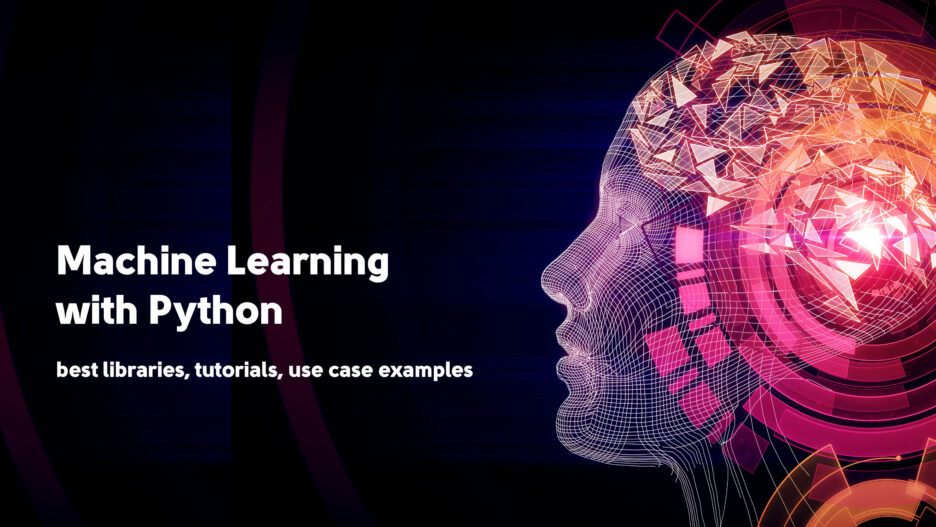Python and Machine Learning have strengthened data science and IT. Many machine learning professionals utilize Python for customer segmentation, web development, process automation, and software application development.
As such, it’s no wonder that developers pair Python with AI, Machine Learning, and Deep Learning projects. In this blog, we cover everything you need to know about working with Machine Learning using Python. From benefits, courses, machine learning Python books, use cases, libraries, and more, this is your one-stop shop for all things related to Machine Learning and Python.
Why is Python One of the Best Programming Languages for Machine Learning?
Python libraries for machine learning and frameworks simplify programming. Also, it's the go-to programming language for machine learning, which helps. NumPy and SciPy are popular scientific computing, data mining, and analysis libraries. Other inbuilt libraries for Machine Learning and Artificial Intelligence include:
- scikit-learn for data mining, analysis, and Machine Learning
- Tensorflow, a high-level neural network library, and
- pylearn2 for data mining and Machine Learning, which is considered more versatile than scikit-learn
Easy to learn and use. Python code is straightforward and easy to understand, making it ideal for machine learning and deep learning projects. Python's human-readable scripting allows coders to test hypotheses and deploy algorithms quickly. Because of the many libraries, resources, and tools accessible, even beginners can use Python for Machine Learning.
Large online community. Python code is easy to understand, making it suitable for machine learning and deep learning. Python's human-readable scripting lets coders test theories and implement algorithms quickly. Python for Machine Learning is easy to use with so many libraries, resources, and tools. Some cool online Python communities where you can engage in peer-to-peer learning include Python’s Discord, PySlackers, Real Python, Full Stack Python, PythonistaCafe, and more.
Unparalleled flexibility. Python can integrate with other languages. This makes it easy to integrate with other AI initiatives. Python is flexible and portable, thus it can handle cross-language tasks. Python's versatility makes training machine learning models easy.
Visualization. Python offers many libraries and frameworks, as noted. Some tools and frameworks contain valuable visualization features that are crucial in AI, Machine Learning, and Deep Learning to display data in an easy-to-digest fashion. You can find libraries for almost any data visualization need in the Python Package Index, from GazeParser for eye movement research, Matplotlib for charts, histograms, and plots, to pastalog for realtime visualizations of neural network training.
Where to start with Python for Machine Learning?
It's scary to learn something new, enhance one's expertise, or enter into a continually evolving technology. You're in the right place if you're unsure how to start machine learning with Python. Next, we list learning resources.
- Step-by-step tutorial of a machine learning project in Python. Here, the author walks you through getting started on a simple machine learning project using Python as a machine learning beginner. The author also references their machine learning Python book, Machine Learning Mastery with Python, which offers several step-by-step tutorials on the same subject as well as Python source code files. This course teaches developers how to create machine learning-based prediction functions.
- Community pool of tutorials and resources focused on Python Machine Learning. Real Python, one of the largest online Python communities, compiled various Machine Learning lessons in Python.
- Intro training coursethat covers several aspects of machine learning in relation to Python development. Some topics include Neural Networks, Naive Bayes Classifier, text classification, data visualization, k-Nearest-Neighbor Classifier, and more.
- Fundamentals of using Machine Learning with Python to advance course-takers so they can create projects. This course covers getting started with machine learning, the best Python modules for Machine Learning, data processing, supervised learning, linear regression, polynomial regression, logistic regression, Naive Bayes, decision trees, random forests, unsupervised learning, clustering, and more.
- Pool of Python resources and courses that focus on machine learning. From beginner-friendly courses to intermediate, and advanced, this collection of Python courses covers nearly every topic under the sun for Python and Machine Learning.
- A Python and Data Science and Machine Learning BootCamp. This is a great course for Python data science and machine learning. NumPy, Pandas, Seaborn, Matplotlib, Plotly, Scikit-learn, Meeshkan, TensorFlow, and Keras are covered. This course is for beginners and experienced developers interested in data science.
- Supervised Machine Learning course that focuses on Regression and Classification. By Andrew Ng, this is one of the most popular courses out there to learn machine learning.
Recommended Machine Learning Python Books
Here’s a roundup of some of the best and highly recommended books for employing Machine Learning using Python.
- “Automate The Boring Stuff With Python” by Al Sweigart. This beginner's programming guide teaches Python to do in minutes what would take hours manually. This helps readers learn programming basics and build Python programs to automate activities.
- “Python for Data Analysis” by Wes McKinney. Learn Python to manipulate, clean, and crunch datasets. You'll learn pandas, NumPy, IPython, and Jupiter. Wes McKinney, the inventor of Python pandas, wrote this comprehensive introduction to Machine Learning with Python data science tools. It's fantastic for Python programmers new to data science and scientific computing.
- “Python Cookbook” by David Beazley and Brian Jones. This book helps build Python 3 apps and update Python 2 code. It focuses on current Python tools and idioms and contains Python 3.3 recipes. Each recipe includes code examples and an explanation of how and why the approach works.
- “Machine Learning with Python Cookbook” by Chris Albon. This practical guide provides approximately 200 self-contained machine learning recipes. If you know Python and its libraries, such pandas and scikit-learn, you can import and process data, select models, and reduce dimensionality. Each recipe provides code that may be tested in a test dataset. This cookbook provides the nuts and bolts needed to construct machine learning apps.
- “Hands-on Machine Learning with Scikit-Learn and Tensorflow” by Aurélien Géron. Aurélien Géron uses basic examples, little theory, and two production-ready Python frameworks—scikit-learn and TensorFlow—to help you develop intelligent systems. You'll learn linear regression, neural networks, and more.
- “Data Visualization in Python” by Daniel Nelson. Data Visualization in Python is a book for starting to intermediate Python developers. It covers fundamental data manipulation with Pandas, charting libraries like Matplotlib and Seaborn, and declarative and experimental libraries like Altair. Knowing how libraries function will help you choose the best one for your visualization project.
- “Introduction to Machine Learning with Python: A Guide for Data Scientists” by Andreas C. Muller and Sarah Guido. This book shows Python beginners how to construct machine learning solutions. You'll learn to develop a machine-learning program with Python and scikit-learn.
- “Deep Learning with Python” by Mike Krebbs. This guidebook explains deep learning using Python and real-world data. It's a step-by-step guide for creating Deep Learning models with Python.
- “Machine Learning For Dummies” by John Paul Mueller and Luca Massaron. This guide quickly helps you make sense of the programming languages and tools you need to convert machine learning-based projects into reality.
- “Machine Learning for Absolute Beginners: A Plain English Introduction” by Oliver Theobald. This book is for beginners. No coding knowledge is needed, and explanations are simple. Tutorials and visual examples make learning fundamental methods easy and fun.
Best Python Libraries for Machine Learning
NumPy
NumPy is a free, open-source Python scientific computing package. It processes arrays and matrices. Here are some of the key features of Numpy.
- high-performing N-dimensional array object: The homogeneous array object is NumPy library's most critical feature. Numpy supports both one- and multi-dimensional arrays.
- one dimensional array: it consists of a single row or column and the elements within are homogeneous in nature.
- multidimensional: it consists of serval rows or columns where each column is a dimension. Similar to Microsoft Excel, the elements are homogeneous.
- C/C+ and Fortran code integration tools: NumPy functions work with code from other languages, and as such, it easily integrates functionalities available in other programming languages.
Some of the best NumPy machine learning in Python tutorials are:
- NumPy quickstart — NumPy v1.22 Manual
- NumPy Tutorial - W3Schools
- Numpy Tutorial: Your First Steps Into Data Science in Python
- NumPy Tutorial - GeeksforGeeks
NumPy works like a charm when paired with Machine Learning, and here are some of the most prominent applications and use cases:
- Alternatives for Python lists and arrays. Python lists are Numpy arrays. Arrays' homogeneous nature makes them essential.
- NumPy consumes very little memory. Python deletes and recreates NumPy arrays as needed. Copying, viewing, and indexing saves memory. Indexing enables data reuse by retrieving the original array's perspective.
- Using NumPy for arrays with multiple dimensions. NumPy can create multidimensional arrays. Multidimensional arrays have more than one column and enable matrix formation. Simple matrices make programming more memory-efficient.
NumPy is used in almost every tech, finance, and major institution. NumPy is used by the NBA, Apple, Microsoft, Intel, and Intel Distribution for Python. You can find other real-life examples of using NumPy: NumPy, NumFOCUS, and Reddit.
SciPy
SciPy, short for Scientific Python, was created by Travis Olliphant. SciPy is used for optimization, analytics, signal processing, math, science, engineering, and tech. SciPy is open source. Key features of SciPy include:
- Fundamental algorithms for optimization, integration, algebraic equations, and more.
- Extends NumPy offering more tools for array computing and specialized data structures like sparse matrices and k-dimensional trees.
- High-performing machine learning Python library with implementations written in Fortran, C, C++, etc.
Some of the best SciPy tutorials are:
- SciPy Introduction
- SciPy Tutorial
- SciPy Tutorial for Beginners
- Beginner’s Guide to Python SciPy with Examples
- SciPy Tuorial: Linear Algebra
SciPy is mostly used for scientific and numeric computing use cases. For example, SciPy and NumPy are used to perform the numerical analysis for Netflix. You can find more use cases and applications here: SciPy, NumFOCUS, and Reddit.
Scikit-learn
Scikit-learn is a Python machine learning library. It works with Python's NumPy and SciPy libraries and contains support-vector machines, random forests, gradient boosting, k-means, and DBSCAN. NumFOCUS supports Scikit-learn. Here are some of Scikit-Learn’s key features.
- Easy inbuilt datasets that can have Machine Learning implemented in them directly.
- Data splitting for training and testing to achieve unbiased prediction performance.
- Logistic regression algorithm.
- Decision trees for classification and regression.
- Random forests are a bagging technique with hundreds/thousands of decision trees create a model.
- K-means clustering unsupervised machine learning algorithm for classification.
Some of the best Scikit-learn tutorials are:
- Scikit Learn Tutorial
- Scikit-Learn Tutorial: How to Install & Scikit-Learn Examples
- Python Machine Learning: Scikit-Learn Tutorial
Scikit-learn can be used to solve supervised, unsupervised, and reinforcement learning challenges in machine learning. Here are some prominent companies using Scikit-Learn.
- J.P.Morgan. JPMorgan's Python machine learning toolset includes Scikit-learn. Classification, predictive analytics, and a slew of other machine learning activities all rely on it.
- Spotify. Scikit-Learn offers Spotify cutting-edge models and a wide range of solid implementations. It’s widely used for music recommendations.
- Evernote. For the most part, developing a classifier is a series of iterative steps that begin with data exploration, feature selection, model training, and model evaluation, which is why Evernote relies on the Scikit-Learn package.
You can find more use case machine learning and applications of Scikit-Learn here: Scikit-Learn, NumFOCUS, and Reddit.
Tensorflow
In order to construct and train models in Python or JavaScript, TensorFlow provides a set of procedures that can be used on-prem or in the cloud, in the browser, or on a mobile device. Some of TensorFlow’s key features include:
- TensorFlow apps can be run on Android, the cloud, iOS, and other architectures including CPUs and GPUs, allowing them to be executed across several embedded platforms.
- You can reflect on each node individually to evaluate and achieve fast debugging.
- Computational graphing methods and dashboards.
- It works with multidimensional arrays using three types of criteria: rank, type, and shape.
- TensorFlow ensures raw data is presented in a way that neural networks can understand to train models.
Some of the best Tensorflow tutorials include:
- TensorFlow Tutorials
- Tutorials | TensorFlow Core
- TensorFlow Tutorial For Beginners
- TensorFlow 2 Tutorial: Get Started in Deep Learning With tf.keras
- From Solving Equations to Deep Learning: A TensorFlow Python Tutorial
Here are some prominent companies using TensorFlow:
- Airbnb uses TensorFlow to improve guest experiences by classifying images and detecting objects at scale.
- China Mobile improves the success rate of network element cutovers thanks to TensorFlow.
- GE trained a neural network with the help of TensorFlow to identify the anatomy of MRIs of the brain.
You can find more use cases and applications of TensorFlow here:TensorFlow, BuiltinSF, and Reddit.
PyTorch
PyTorch is a Python-based scientific computing software that mainly has two purposes:
- Take advantage of accelerators like GPUs and CUDA.
- Neural network implementations.
PyTorch provides a user-friendly front-end, distributed training, and an ecosystem of tools and modules for fast, flexible experimentation and efficient production. Some of the key features of PyTorch.
- TorchScript for ease of use and flexibility
- Seamless transition to graph mode for speed, optimization, and functionality in C++ runtime environments.
- TorchServe for deploying PyTorch models at scale.
- Distributed training to optimize performance with native support for asynchronous execution of operations and peer-to-peer communication from Python and C++.
- End-to-end workflow supports deploying Python on iOS and Android.
- An active community of researchers and developers with a rich pool of libraries and tools.
Some of the best PyTorch tutorials include:
- PyTorch Tutorials 1.11.0+cu102 documentation
- Learning PyTorch with Examples
- PyTorch Tutorial: How to Develop Deep Learning Models
- PyTorch Tutorial for Deep Learning Researchers
- PyTorch Fundamentals
With examples like reinforcement learning, image classification, and natural language processing, PyTorch is known for being convenient and adaptable. Here are some prominent companies using PyTorch.
- Deep neural networks have made it possible for computers to interpret natural language, from Siri to Google Translate. PyTorch simplifies the development of models like these and many more in the field of natural language processing.
- For NLP and multi-task learning, Salesforce makes use of PyTorch.
- Thanks to PyTorch's adaptability, Stanford University is rapidly exploring new algorithmic approaches.
You can find more use cases and applications of PyTorch here:TorchServe Use Cases, Common use cases — PyTorch Lightning 1.6.4 documentation, and Reddit.
Theano
Multi-dimensional array mathematical expressions can be defined, optimized and swiftly evaluated using the Theano Python package. Theano uses NumPy as a foundation and comprises the following key features:
- A NumPy-like user interface with Theano-compiled functions that make use of numpy.ndarrays.
- A GPU to conduct data-intensive computations up to 140 times faster than on a CPU.
- Effective symbolic differentiation for functions with one or more inputs.
- Stability improvements to avoid severe issues when computing big values of x of formulas.
- Faster evaluation of expressions.
- Defect discovery tools as well as rigorous unit testing.
Some of the best Theano tutorials include:
- theano Getting started with theano
- Theano Deep Learning Tutorial for Beginners
- Introduction to the Python Deep Learning Library Theano
As an important Python Deep Learning library, it can be used directly to build Deep Learning models or as a wrapper library to make the process much more straightforward. You can find use cases and applications of Theano here:
Keras
Keras is a Python-based deep learning API that runs on top of TensorFlow, a machine learning framework. An emphasis was placed on speeding up the process of experimenting.
- Sophisticated yet not trite. You may focus on the most important aspects of the problem with Keras, which lessens the burden on your brain.
- Simple workflows should be quick and straightforward while more difficult workflows should be possible via a clear path that builds on what you've already learned. This is the notion of progressive disclosure of complexity that Keras adheres to.
- Extremely effective and scalable — Keras is utilized by firms like NASA, YouTube, and Waymo because of its high performance and scalability.
Some of the best Keras tutorials include:
- Your First Deep Learning Project in Python with Keras Step-By-Step
- The Ultimate Beginner's Guide to Deep Learning in Python
- KERAS Tutorial: DEEP LEARNING in PYTHON
- Getting started: training and prediction with Keras
You can see examples and use cases of Keras here:
Conclusion
Artificial Intelligence and Machine Learning with Python are continually growing and bridging gaps in a variety of industries. Implementing similar practices across industries can help boost production and effectiveness. Python's employment in these technologies is assisting in the provision of solutions to real-world challenges.
To get the most out of machine learning in Python, you must understand how to combine the finest algorithms with the appropriate tools and procedures. Svitla Systems' engineers and ML experts have rich, collective expertise that combines a long and illustrious history in statistics and data mining with cutting-edge architectural innovations to ensure that your business needs are met with models that run as quickly as possible – from small to large business situations.
Svitla Systems has significant experience and capacity to work with Machine Learning across different programming languages, including Python. Care to learn more? Reach out to our helpful representatives and they’ll be happy to elaborate.





